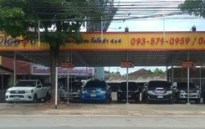[ad_1]
Scratch holograms are holograms that are readily drawn by hand using a technique discovered by Bill Beaty. Scratch holograms are best viewed using a “point” light source; that is, a small, bright light that is far enough away from the surface, such as the sun. It is often easiest to place the hologram on a flat surface (such as the ground) and move around the hologram to find the correct angle for the light. The light reaching the surface of the hologram should reflect off of the scratches on the surface and appear as a single, bright point of light on each scratch. The hologram appears as a pattern of bright points of light which move as you change your position (or that of the hologram or light source). An LED flashlight or halogen spotlight trained on the hologram in a darkened room also generally provides good viewing conditions. Note that the angle of illumination and viewing are very important, so you may need to move things around until you get a good image.
We are making our scratch holograms for Maker Faire via two hand-drawn methods. The first is very much analogous to the technique described here. Instead of manually placing a compass tip on a pattern, we have pre-dilled patterns used to position a scribing arm at each point in sequence. This method is very time-consuming, since a good hologram can require hundreds of arcs to be drawn individually. The second method we use is to draw a pattern with glue and adhere fine sand to the glue. This pattern is then drawn directly over the plastic surface in one arcing motion, leaving a less precise but often quite good scratch hologram.
This is most likely due to the fact that the vinyl cutter traces arcs that have tiny (less than one millimeter) wiggles in them because of the way the motors in the cutter work. These wiggles effectively broaden the area on each scratch where the light reflects, creating a blurry hologram that is not nearly as pleasing as the hand-drawn ones. Research is ongoing toward automating the process of fabricating scratch holograms with less manual effort.
Scratch holograms are like conventional photographs in that the film-plate itself does not preserve the phase of the illuminating light source, and therefore they are not holograms. This is wrong: the polished scratches do preserve horizontal phase information. Remember that mirrors preserve the phase of reflected light. So also do the interference patterns of conventional Rainbow holograms. So do cylinder lenses and shiny fibers. And so do the polished scratches of “scratch holograms”. Eliminate the phase by painting the scratches white, and you also eliminate the 3D depth effect. True, “Scratch holograms” are astigmatic, preserving the horizontal phase (and the horizontal parallax) while scrambling the vertical phase. Each scratch in a “scratch hologram” acts as a tiny cylindrical mirror, and it reflects light like a flat mirror in one dimension while scattering light in the other. As a result, both rainbow holograms and “scratch holograms” only have horizontal parallax, and the 3D effect will vanish if they are turned sideways. Their horizontal parallax depends upon their ability to preserve horizontal spatial phase of the illuminating light source. It’s like looking into a curved, slit-shaped mirror.
The Scratches interact (overlapped scratches destroy one another.) In true holography the light waves add linearly, and one wave does not block the effects of another. “Stamping” of complete zoneplate patterns onto the plastic is not an additive process as it would be with light. However there is a cure: divide the film-plane itself into pixels, then move any overlapping scratches within each pixel so they no longer overlap, but so they do not alter the 3D image by moving outside their pixel boundaries. This allows the “scratch-holo” technique to reproduce arbitrary scenes, rather than only being used for glowing white lines on a dark background.
[ad_2]
Source by Ashok Arora

 2/1 Rattanakosin Road,
Si Phum, Muang, Chaing Mai
CONTACT# 0932387148
2/1 Rattanakosin Road,
Si Phum, Muang, Chaing Mai
CONTACT# 0932387148
 19/8 Moo.3 Makham
Tia, Muang, Surat Thani.
CONTACT# 0935790959, 0986716951
19/8 Moo.3 Makham
Tia, Muang, Surat Thani.
CONTACT# 0935790959, 0986716951

